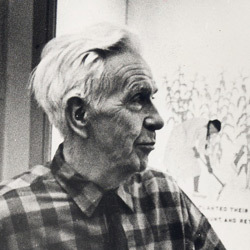
Gustav Dalstrom
b. 1893, Gotland, Sweden - d. 1971, Chicago, IL
Born in Sweden in 1993, Gustav Dalstrom came to the United States with his family in 1900, settling in Chicago. After attending Lane Technical High School, he enrolled at the School of the Art Institute of Chicago (SAIC), where he studied with J. Wellington Reynolds and, after a short period in the Army, returned to classes with the popular New York urban realists George Bellows and Randall Davey who were visiting instructors at SAIC in 1919–20. These artists, who worked in a style accessible to Midwestern students, were important for their rejection of arbitrary academic rules still commonly taught at the institution; instead, they emphasized relying on one’s own instincts and painting what one knew. Like these teachers, Dalstrom worked in a representational style, focusing on scenes of the urban life around him, including the many leisure activities that observed firsthand. In 1928, along with Frances Foy, whom he married in 1923, and their artist friends Frances Strain and Fred Biesel and Hazel and Vin Hannell, Dalstrom traveled to Europe where he studied art intensively and visited his birthplace in Sweden.
Dalstrom was active in the progressive art world of Chicago in the 1920s and 30s. He exhibited with the independent Chicago No-Jury Society of Artists, and its New York counterpart, the Society of Independent Artists, as well as the Chicago Society of Artists, the Ten (Chicago), and the Chicago Society of Etchers. He was regularly included in the juried annuals at the Art Institute and exhibited at the Whitney Museum as well as other national venues. He served in leadership positions for the No-Jury Society and the Chicago Society of Artists and won numerous prizes including a Gold Medal from the Chicago Society of Artists, and the annual award of Chicago Society of Etchers. In order to support himself and his family, he worked for several commercial engraving companies as well as designing and executing displays at the Field Museum of Natural History
Dalstrom and Foy settled in the Lincoln Park neighborhood of Chicago, in close proximity to the park and its lagoon, shaded paths, zoo, and ice-skating pond, which inspired many of their paintings. Attesting to their interest in this subject, in 1948 the Dalstroms had a joint show in which they exhibited forty-eight of their Lincoln Park scenes, perhaps including those in this collection. The Bridges, South Pond (Lincoln Park) of 1924 depicts the range of leisure activities taking place in the park on a warm, sunny afternoon: strollers, boaters, and bench sitters, children and adults, gather in the park in a scene reminiscent of Seurat’s Sunday Afternoon on the Grande Jatte, which entered the Art Institute’s permanent collection in 1926. Like the New York urban realists he so admired, he glorified the activities of ordinary urban dwellers, whose clear simplified shapes suggest familiarity with both the urban shoppers of Kenneth Hayes Miller and the flappers of Guy Pène du Bois.
Sunday in Lincoln Park shows a family enjoying the day in a less crowded area of the park, in a composition that calls to mind Manet’s Déjeuner sur l’herbe. Considering Dalstrom’s recent trip to Europe (including Paris), it is certainly possible that he was influenced by this famous Impressionist painting; while not contemporary modernism, nineteenth-century French Impressionist painting was extraordinarily popular with Chicagoans. Dalstrom’s scene, in contrast to Manet’s, has a fully clothed central figure and is much more akin to the scenes of New Yorkers such as John Sloan. Untitled (Spring dance) also evokes Bellows’s and Davey’s New York circle. In this masterful watercolor, Dalstrom conveys a joy in living in the bright color and deft brushwork, but grounds the image clearly in its Lincoln Park setting.
Dalstrom was very active working on the government art projects in the 1930s, executing numerous murals for the Federal Art Project (FAP) as well as serving as supervisor in the mural division. He was also selected to paint murals for the Treasury Section of Fine Arts, the competitive, non-need based program that supplied murals to Federal buildings, most notably Post Offices. Foy and Dalstrom worked together on the murals for the Chestnut Street Post Office (now located in the downtown Chicago post office) and Dalstrom produced the monumental twelve-panel series of frescoes for the St. Joseph, Missouri Post Office in 1941. Dalstrom may have painted Untitled (Watering Hole) in the Ozarks during this sojourn in Missouri. The almost primitive image, simplified and flattened, contrasts with the earlier and more substantial Bridges (South Pond). Whether this is a result of stylistic development or is conditioned by the pastoral setting is unclear. In any case, it speaks in the same straightforward language of the delights of everyday life.
Susan Weininger
References
Dalstrom, Gustaf. “Statement.” In J. Z. Jacobson. Art of Today: Chicago, 1933, 58. Chicago: L. M. Stein, 1932.
Flavin, Genevieve, “Exhibit Reveals Lincoln Park of Earlier Day.” Chicago Sunday Tribune, August 8, 1948.
Greenhouse, Wendy, and Susan Weininger. Chicago Painting 1895–1945: The Bridges
Collection. Exh. cat. Springfield: University of Illinois Press and Illinois State Museum, 2004.
Park, Marlene, and Gerald E. Markowitz, Democratic Vistas: Post Offices and Public Art in New Deal. Philadelphia: Temple University Press, 1984.
Weininger, Susan. “Gustaf Dalstrom.” In Chicago Modern, 1893–1945: The Pursuit of the New. Edited by Elizabeth Kennedy, 104. Chicago: Terra Museum of American Art, 2004.
“Dalstroms Capture 25 Years in Lincoln Park on Canvas.” North Side Sunday Star, July 4, 1948.
Artist image: Photograph of Gustaf Dalstrom, November 1970, collection of Bernard Friedman.

